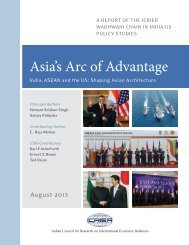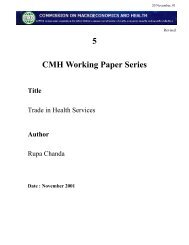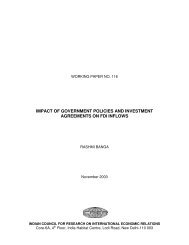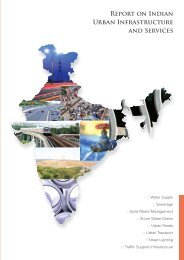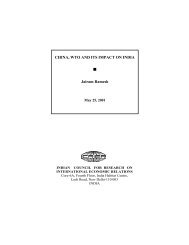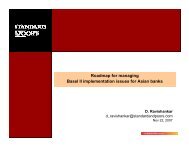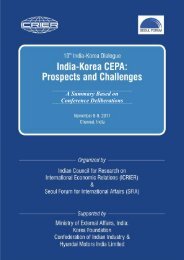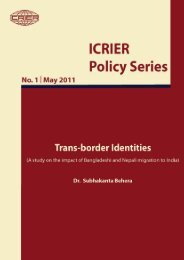an analysis for india and china - icrier
an analysis for india and china - icrier
an analysis for india and china - icrier
Create successful ePaper yourself
Turn your PDF publications into a flip-book with our unique Google optimized e-Paper software.
1 Introduction ∗<br />
Reduction of trade barriers creates competitive pressures <strong>an</strong>d the potential <strong>for</strong><br />
technology tr<strong>an</strong>sfer so as to lead to productivity gains <strong>an</strong>d restructuring of <strong>an</strong> economy<br />
toward its comparative adv<strong>an</strong>tage. India has undertaken a series of economic re<strong>for</strong>ms<br />
towards opening up of the economy in the decade of the nineties. Notable among these<br />
has been the extensive ef<strong>for</strong>t to liberalize its international trade. It is there<strong>for</strong>e expected<br />
that trade liberalization in India would have led to ch<strong>an</strong>ges in the composition of exports<br />
so as to reflect India’s comparative adv<strong>an</strong>tage in the global economy. Further, a country’s<br />
comparative adv<strong>an</strong>tage in international trade may be influenced by differential rates of<br />
ch<strong>an</strong>ge in accumulation of production factors or due to the increased trade integration of<br />
other countries. China’s recent move towards export oriented development strategy may<br />
have altered the picture of comparative adv<strong>an</strong>tage <strong>for</strong> labor intensive m<strong>an</strong>ufactures in the<br />
world market. Across developing countries there is <strong>an</strong> ongoing debate <strong>an</strong>d emerging<br />
concern about the threat <strong>an</strong>d opportunity in relation to the rise of China <strong>an</strong>d the<br />
consequent intensification of competition in labour intensive m<strong>an</strong>ufactures. The debate is<br />
even more pertinent in case of India, as China <strong>an</strong>d India are not just similar in size but<br />
also with respect to factor endowments. It is import<strong>an</strong>t there<strong>for</strong>e, to explore the structure<br />
of comparative adv<strong>an</strong>tage of India <strong>an</strong>d China <strong>an</strong>d the extent to which the two economies<br />
compete with each other in the global market <strong>for</strong> m<strong>an</strong>ufacturing sector commodities. This<br />
paper makes <strong>an</strong> attempt to develop some insights on the subject.<br />
Specifically, the paper examines the structure of comparative adv<strong>an</strong>tage enjoyed<br />
by India <strong>an</strong>d China in the global market, individually <strong>an</strong>d in a comparative framework.<br />
Following this, <strong>an</strong> <strong>an</strong>alysis of the comparative adv<strong>an</strong>tage according to factor intensity <strong>for</strong><br />
the two economies is undertaken. The pattern of comparative adv<strong>an</strong>tage is also examined<br />
<strong>for</strong> inter-temporal variation over the period 2000-2003. The <strong>an</strong>alysis of comparative<br />
adv<strong>an</strong>tage has been undertaken using the Balassa (1965) index of revealed comparative<br />
adv<strong>an</strong>tage <strong>for</strong> the two <strong>an</strong>d six digit level of HS classification. Comparative adv<strong>an</strong>tage<br />
∗ I express my gratitude to Prof. Arvind Virm<strong>an</strong>i who motivated me to take up this research study. Prof.<br />
Virm<strong>an</strong>i made valuable suggestions which are reflected in the final paper. Th<strong>an</strong>ks are also due to<br />
particip<strong>an</strong>ts at the ICRIER seminar <strong>for</strong> giving useful comments<br />
1




